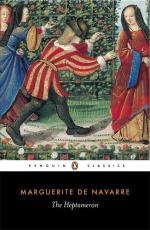12 The letters of remission which were granted to St. Aignan on this occasion will be found in the Appendix to the First Day (B). It will be noted that Margaret in her story gives various particulars which St. Aignan did not fail to conceal in view of obtaining his pardon.—L.
To this end he went in disguise to Paris with his wife. She, finding that he used to shut himself up for a great while in a room with Gallery without acquainting her with the reason thereof, spied upon him one morning, and perceived Gallery showing him five wooden images, three of which had their hands hanging down, whilst two had them lifted up.(13)
“We must make waxen images like these,” said Gallery, speaking to the Proctor. “Such as have their arms hanging down will be for those whom we shall cause to die, and the others with their arms raised will be for the persons from whom you would fain have love and favour.”
“This one,” said the Proctor, “shall be for the King by whom I would fain be loved, and this one for Monseigneur Brinon, Chancellor of Alencon.” (14)
13 This refers to the superstitious practice called envoutement, which, according to M. Leon de Laborde, was well known in France in 1316, and subsisted until the sixteenth century. In 1330 the famous Robert d’Artois, upon retiring to Brabant, occupied himself with pricking waxen images which represented King Philip VI., his brother-in- law, and the Queen, his sister. (Memoires de l’Academie des Inscriptions, vol. xv. p. 426.) During the League the enemies of Henri III. and the King of Navarre revived this practice.—(L.) It would appear also from a document in the Harley MSS. (18,452, Bib. N’at., Paris) that Cosmo Ruggieri, the Florentine astrologer, Catherine de’ Medici’s confidential adviser, was accused in 1574 of having made a wax figure in view of casting a spell upon Charles IX.—M.
14 John Brinon, Councillor of the King, President of the Parliament of Rouen, Chancellor of Alencon and Berry, Lord of Villaines (near Dreux), Remy, and Athueuil (near Montfort-l’Amaury), belonged to an old family of judicial functionaries. He was highly esteemed by Margaret, several of whose letters are addressed to him, and he was present at the signing of her marriage contract with Henry II. of Navarre (Genin’s Lettres de Marguerite, p. 444). He married Pernelle Perdrier, who brought him the lordship of Medan, near Poissy, and other important fiefs, which after his death she presented to the King. His praises were sung by Le Chandelier, the poet; and M. Floquet, in his History of the Parliament of Normandy, states that Brinon rendered most important services to France as a negotiator in Italy in 1521, and in England in 1524. The Journal d’un Bourgeois de Paris mentions that he died in Paris in 1528, aged forty-four, and was buried in the Church of St. Severin.—L. According to La Croix du Maine’s Bibliotheque Francoise, Brinon was the author of a poem entitled Les Amours de Sydire.—B. J.
“The images,” said Gallery, “must be set under the altar, to hear mass, with words that I will presently tell you to say.”




